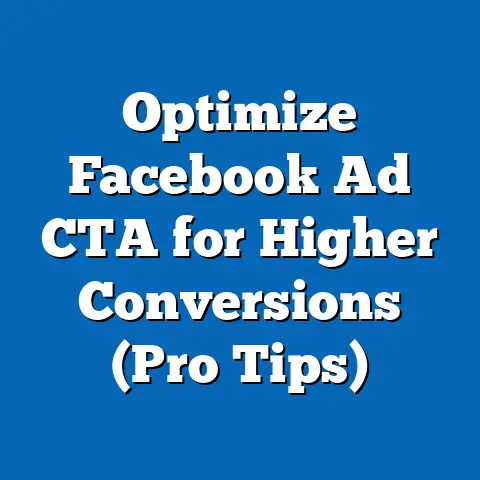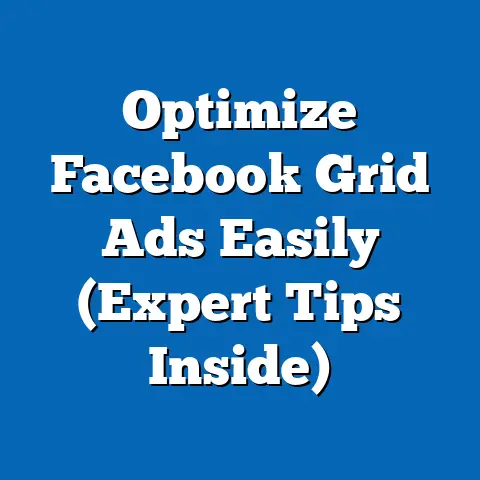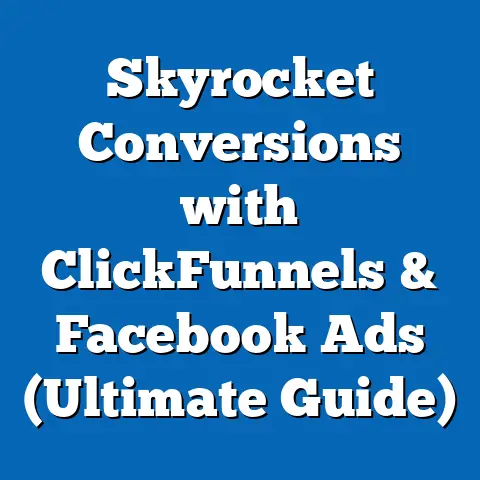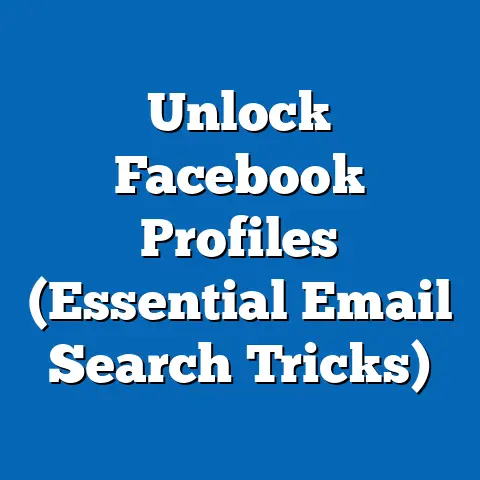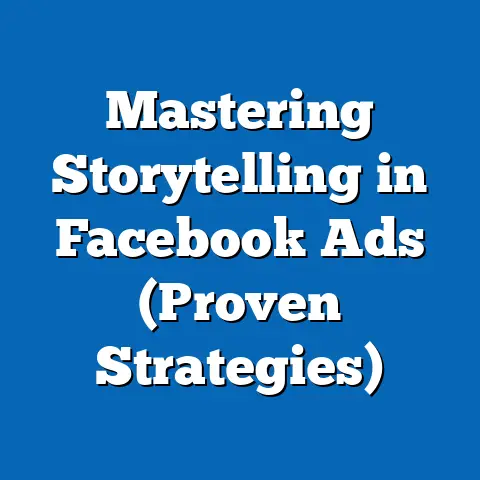Boost Facebook Ads for College Access (Pro Tips Inside)
Imagine a world where every student, regardless of their background, has the opportunity to pursue higher education. It’s a powerful vision, and one that relies on effective outreach and engagement. Just like energy efficiency saves money and resources, investing in well-crafted Facebook ads can yield significant returns for college access initiatives, reaching the students, parents, and communities who need these opportunities most.
I’ve personally seen the transformative power of education, and I believe that access to college can change lives. But getting the word out about available resources and programs can be a real challenge for many organizations. That’s where the strategic use of Facebook advertising comes in. It’s not just about throwing money at ads; it’s about understanding your audience, crafting compelling content, and using the platform’s features to their fullest potential.
In this guide, I’ll walk you through the essential steps to leverage Facebook ads for college access, sharing practical tips and insights I’ve gained from years of experience in digital marketing and working with educational initiatives. We’ll cover everything from defining your target audience to analyzing your ad performance, ensuring that your message reaches the right people and inspires them to take action. By the end, you’ll have the knowledge and tools you need to create impactful Facebook ad campaigns that make a real difference in your community.
Section 1: Understanding Your Audience
Before diving into ad creation, it’s crucial to understand who you’re trying to reach. College access isn’t a one-size-fits-all concept. Potential college students come from diverse backgrounds with varying needs and aspirations.
Demographics of Potential College Students
Think about the demographics of the students you want to reach. Here are some key considerations:
- Age: Are you targeting traditional high school students, non-traditional students returning to education, or parents of younger children planning for the future?
- Interests: What are their hobbies, passions, and career goals? Are they interested in STEM fields, the arts, or business?
- Geographic Location: Are you focusing on local students within a specific city or region, or are you targeting a broader national or international audience?
- Socioeconomic Background: What are the financial challenges they might be facing? Are they eligible for scholarships or financial aid programs?
Understanding these demographics is crucial for tailoring your messaging and targeting your ads effectively. For example, an ad targeting first-generation college students might emphasize the support systems available to them, while an ad targeting parents might highlight the long-term financial benefits of a college education.
Utilizing Facebook Insights and Audience Insights
Facebook provides powerful tools to research and identify your target audience: Facebook Insights and Audience Insights.
- Facebook Insights: This tool provides data about your existing Facebook page followers, including their demographics, interests, and engagement patterns. It’s a great way to understand the audience you’re already reaching.
- Audience Insights: This tool allows you to explore potential audiences based on demographics, interests, behaviors, and more. You can use it to identify new targeting opportunities and refine your understanding of your ideal audience.
I remember working with a local non-profit that wanted to increase enrollment in their college prep program. They thought their target audience was primarily low-income students from a specific neighborhood. However, after using Audience Insights, we discovered that a significant portion of their existing students were also interested in specific extracurricular activities like debate club and coding. This insight allowed us to refine our ad targeting and reach a more engaged audience.
Tailoring Messaging and Ad Content
The key to successful Facebook advertising is relevance. Your ads must resonate with your target audience on an emotional level. This requires empathy and a deep understanding of their needs and aspirations.
- Speak their language: Use language that is authentic and relatable to your target audience. Avoid jargon or overly formal language.
- Address their pain points: What are the challenges they’re facing? Are they worried about the cost of college, the application process, or their ability to succeed in higher education?
- Highlight the benefits: What are the positive outcomes they can expect from pursuing higher education? Will it lead to better job opportunities, increased earning potential, or personal fulfillment?
Remember, you’re not just selling college access; you’re selling a brighter future. By understanding your audience and tailoring your messaging to their specific needs, you can create ads that inspire them to take action.
Key Takeaway: Deeply understanding your target audience is the foundation of successful Facebook advertising for college access. Use Facebook Insights and Audience Insights to research demographics, interests, and behaviors, and tailor your messaging to resonate with their specific needs and aspirations.
Section 2: Crafting Compelling Ad Content
Once you know who you’re targeting, the next step is to create ad content that grabs their attention and compels them to learn more.
Elements of Effective Ad Copy
Effective ad copy is clear, concise, and emotionally engaging. It should quickly convey the value proposition of your college access program and inspire viewers to take action.
- Clarity: Make sure your message is easy to understand. Avoid jargon or overly technical language.
- Emotional Appeal: Connect with your audience on an emotional level. Use storytelling, imagery, and language that evokes feelings of hope, aspiration, and empowerment.
- Strong Call-to-Action (CTA): Tell viewers exactly what you want them to do. Use clear and concise CTAs like “Learn More,” “Apply Now,” or “Register Today.”
I’ve found that asking questions in your ad copy can be a great way to engage viewers and pique their interest. For example, instead of saying “Our college prep program helps students succeed,” you could ask “Are you ready to unlock your college potential?”
Examples of Successful Ad Copy
Here are a few examples of successful ad copy that speaks directly to the aspirations and concerns of prospective college students:
- Targeting First-Generation Students: “You’re the first in your family to dream of college. We’re here to help you navigate the path. Get personalized support and guidance every step of the way.”
- Targeting Students Concerned About Cost: “Don’t let the cost of college hold you back. Discover scholarships, grants, and financial aid options that can make your dream a reality.”
- Targeting Students Interested in STEM Fields: “Unlock your potential in science, technology, engineering, and math. Explore exciting career paths and connect with mentors who can help you succeed.”
Remember to tailor your ad copy to the specific interests and concerns of your target audience. The more relevant and engaging your message, the more likely viewers are to take action.
The Importance of Visuals
Visuals are a critical component of effective Facebook advertising. Images and videos can capture attention, convey emotion, and tell a story in a way that words alone cannot.
- High-Quality Images: Use clear, well-lit images that are visually appealing and relevant to your message.
- Engaging Videos: Create short, engaging videos that highlight the benefits of your college access program.
- Diversity and Inclusion: Ensure that your visuals reflect the diversity of your community and the students you’re trying to reach.
I always recommend using real photos and videos of students and program participants whenever possible. Authenticity is key to building trust and credibility.
Testimonials and Success Stories
Testimonials and success stories are powerful tools for building credibility and showcasing the impact of your college access program.
- Video Testimonials: Short video testimonials from past participants can be incredibly compelling.
- Written Testimonials: Share written testimonials on your website and in your ad copy.
- Success Stories: Highlight the achievements of past participants, such as their college acceptances, scholarships, or career successes.
When I worked with a scholarship program, we created a series of video testimonials featuring past recipients. These videos were incredibly effective in inspiring new students to apply and demonstrating the tangible benefits of the program.
Key Takeaway: Compelling ad content is essential for capturing attention and driving conversions. Craft clear, emotionally engaging ad copy, use high-quality visuals, and leverage testimonials and success stories to build credibility and showcase the impact of your college access program.
Section 3: Utilizing Facebook Ad Formats
Facebook offers a variety of ad formats to choose from, each with its own strengths and ideal use cases. Understanding these formats can help you create more engaging and effective ads.
Carousel Ads
Carousel ads allow you to showcase multiple images or videos in a single ad unit. This format is ideal for highlighting different aspects of your college access program, showcasing multiple success stories, or promoting a series of related events.
- Visual Storytelling: Use carousel ads to tell a visual story about your program and the students you serve.
- Showcase Multiple Benefits: Highlight different benefits of your program in each carousel card.
- Promote Multiple Events: Promote a series of upcoming workshops, informational sessions, or college tours.
I’ve seen carousel ads work incredibly well for showcasing the different resources and support services offered by a college access program. Each card can highlight a specific resource, such as tutoring, mentoring, or financial aid assistance.
Video Ads
Video ads are highly engaging and can be used to convey complex information in a concise and visually appealing way. They’re ideal for sharing testimonials, showcasing program highlights, or promoting upcoming events.
- Short and Sweet: Keep your videos short and to the point. Aim for videos that are 15-30 seconds long.
- Mobile-First: Optimize your videos for mobile viewing. Use vertical or square aspect ratios and add captions for viewers who are watching with the sound off.
- Compelling Storytelling: Use video to tell compelling stories about the impact of your college access program.
I always recommend starting your video with a hook that grabs viewers’ attention within the first few seconds. A compelling question, a surprising statistic, or a captivating visual can all be effective ways to draw viewers in.
Slideshow Ads
Slideshow ads are a cost-effective way to create engaging video-like experiences using static images. They’re ideal for showcasing program highlights, sharing testimonials, or promoting upcoming events.
- Easy to Create: Slideshow ads are easy to create using Facebook’s built-in tools.
- Cost-Effective: They’re a more affordable alternative to video ads.
- Visually Appealing: Use high-quality images and engaging transitions to create a visually appealing slideshow.
I’ve found slideshow ads to be particularly effective for promoting upcoming workshops or informational sessions. You can use the slideshow to highlight the key topics that will be covered and showcase the speakers or facilitators.
Stories Ads
Stories ads appear in the Stories section of Facebook and Instagram. They’re a great way to reach younger audiences and promote your college access program in a visually immersive way.
- Authentic and Engaging: Stories ads should feel authentic and engaging. Use behind-the-scenes footage, user-generated content, and interactive elements like polls and quizzes.
- Mobile-First: Optimize your Stories ads for mobile viewing. Use vertical aspect ratios and keep your message concise.
- Call-to-Action: Include a clear call-to-action that encourages viewers to learn more, apply, or register.
I’ve seen Stories ads work incredibly well for promoting college tours or campus visits. You can use the Stories format to give prospective students a virtual tour of the campus and showcase the student life experience.
Key Takeaway: Facebook offers a variety of ad formats to choose from. Experiment with different formats to see which ones resonate best with your target audience and achieve your campaign goals. Carousel ads, video ads, slideshow ads, and Stories ads can all be effective tools for promoting college access initiatives.
Section 4: Setting Up Effective Ad Campaigns
Setting up your Facebook ad campaign correctly is crucial for reaching the right audience and achieving your desired results.
Choosing Campaign Objectives
The first step is to choose a campaign objective that aligns with your goals. Facebook offers a variety of objectives, including:
- Awareness: Increase brand awareness and reach a broad audience.
- Consideration: Drive traffic to your website, generate leads, or increase engagement with your Facebook page.
- Conversion: Drive conversions, such as applications, registrations, or donations.
For college access programs, common campaign objectives include driving traffic to your website, generating leads from prospective students, and increasing registrations for upcoming events.
Selecting Ad Placements
Facebook offers a variety of ad placements, including:
- Facebook Feed: Ads appear in the news feed on Facebook.
- Instagram Feed: Ads appear in the news feed on Instagram.
- Facebook Stories: Ads appear in the Stories section on Facebook.
- Instagram Stories: Ads appear in the Stories section on Instagram.
- Audience Network: Ads appear on third-party websites and apps that are part of Facebook’s Audience Network.
I recommend testing different ad placements to see which ones perform best for your target audience. You can also use automatic placements to allow Facebook to optimize your ad delivery across different placements.
A/B Testing Ad Variations
A/B testing, also known as split testing, involves creating multiple versions of your ad and testing them against each other to see which one performs best. This is a crucial step in optimizing your Facebook ad campaigns.
- Test Different Headlines: Experiment with different headlines to see which ones grab viewers’ attention.
- Test Different Visuals: Test different images and videos to see which ones resonate best with your target audience.
- Test Different CTAs: Experiment with different calls-to-action to see which ones drive the most conversions.
I always recommend testing one variable at a time to isolate the impact of each change. For example, if you’re testing different headlines, keep the visuals and CTAs the same.
Budget Considerations and ROI
Setting a realistic budget is essential for maximizing your return on investment (ROI). Consider the following factors when determining your budget:
- Target Audience Size: The larger your target audience, the more you’ll need to spend to reach them.
- Campaign Duration: The longer your campaign runs, the more you’ll need to spend.
- Competition: The more competition there is for your target audience, the more you’ll need to spend.
I recommend starting with a small budget and gradually increasing it as you see positive results. You can also use Facebook’s budget optimization features to automatically adjust your budget based on performance.
Key Takeaway: Setting up your Facebook ad campaign correctly is crucial for reaching the right audience and achieving your desired results. Choose a campaign objective that aligns with your goals, select the appropriate ad placements, A/B test different ad variations, and set a realistic budget to maximize your ROI.
Section 5: Monitoring and Analyzing Ad Performance
Once your ad campaign is running, it’s essential to monitor its performance and make adjustments as needed.
Key Performance Indicators (KPIs)
Key Performance Indicators (KPIs) are metrics that you can use to track the effectiveness of your Facebook ads. Some common KPIs include:
- Reach: The number of unique people who saw your ad.
- Impressions: The number of times your ad was displayed.
- Engagement Rate: The percentage of people who interacted with your ad (e.g., likes, comments, shares, clicks).
- Click-Through Rate (CTR): The percentage of people who clicked on your ad.
- Conversion Rate: The percentage of people who took a desired action after clicking on your ad (e.g., application, registration, donation).
- Cost Per Click (CPC): The average cost you paid for each click on your ad.
- Cost Per Conversion (CPC): The average cost you paid for each conversion.
I recommend tracking these KPIs on a regular basis to identify areas for improvement.
Using Facebook Ads Manager
Facebook Ads Manager provides a wealth of data and analytics that you can use to monitor your ad performance. You can use it to track your KPIs, analyze your audience demographics, and identify trends in your data.
- Customizable Reports: Create customizable reports to track the metrics that are most important to you.
- Real-Time Data: Access real-time data about your ad performance.
- Audience Insights: Gain deeper insights into your audience demographics and interests.
I always recommend setting up custom dashboards in Facebook Ads Manager to track your KPIs at a glance. This will help you quickly identify any issues or opportunities for improvement.
Ongoing Optimization
Monitoring your ad performance is not a one-time task. It’s an ongoing process that requires continuous optimization.
- Adjust Targeting: Refine your targeting based on your performance data.
- Update Ad Content: Refresh your ad content to keep it engaging and relevant.
- Adjust Budget Allocations: Reallocate your budget to the ads that are performing best.
I’ve found that making small, incremental changes to your ad campaigns over time can lead to significant improvements in performance.
Key Takeaway: Monitoring and analyzing your ad performance is crucial for maximizing your ROI. Track your KPIs, use Facebook Ads Manager to analyze your data, and make ongoing adjustments to your campaigns based on your findings.
Section 6: Building a Community and Following
Facebook isn’t just about running ads; it’s also about building a community around your college access initiative.
Creating Dedicated Groups and Pages
Creating dedicated Facebook groups and pages can help you connect with prospective students, parents, and community members.
- Facebook Page: A Facebook page is a public profile that you can use to share information about your program, post updates, and engage with your audience.
- Facebook Group: A Facebook group is a community where members can connect with each other, share information, and ask questions.
I recommend creating both a Facebook page and a Facebook group to maximize your reach and engagement.
Engaging with Followers
Engaging with your followers is essential for building a strong community.
- Respond to Comments and Messages: Respond to comments and messages promptly and professionally.
- Ask Questions: Ask questions to encourage engagement and spark conversations.
- Run Polls and Quizzes: Use polls and quizzes to gather feedback and learn more about your audience.
- Share Relevant Content: Share articles, videos, and other content that is relevant to your audience’s interests.
I’ve found that running contests and giveaways can be a great way to increase engagement and attract new followers.
User-Generated Content
Encouraging user-generated content (UGC) can help you build trust and credibility.
- Ask Students to Share Their Stories: Encourage students to share their stories about their experiences with your college access program.
- Run Photo Contests: Run photo contests and ask students to submit photos that showcase their college aspirations.
- Feature UGC on Your Page: Feature UGC on your Facebook page to showcase the diversity of your community.
UGC can be a powerful tool for building community and promoting your college access program.
Facebook Live and Events
Facebook Live and events can help you foster real-time engagement and interaction with your audience.
- Host Q&A Sessions: Host Q&A sessions with college admissions officers, financial aid experts, or current college students.
- Live Stream Workshops: Live stream workshops and informational sessions to reach a wider audience.
- Create Facebook Events: Create Facebook events for upcoming workshops, college tours, or informational sessions.
I’ve seen Facebook Live events work incredibly well for answering questions and providing valuable information to prospective students and their families.
Key Takeaway: Building a community and following on Facebook can help you connect with prospective students, parents, and community members. Create dedicated groups and pages, engage with your followers, encourage user-generated content, and use Facebook Live and events to foster real-time engagement.
Conclusion
Effective Facebook advertising can be a game-changer for college access initiatives. By understanding your audience, crafting compelling content, utilizing the right ad formats, setting up effective campaigns, monitoring performance, and building a strong community, you can reach more students, inspire them to pursue higher education, and make a positive impact on your community.
I encourage you to implement the tips and strategies outlined in this guide to enhance your Facebook ad campaigns and make a real difference in the lives of students. Remember, every student deserves the opportunity to pursue their dreams, and with the power of digital marketing, we can help make those dreams a reality.
The future of education is bright, and digital marketing will play an increasingly important role in shaping accessible pathways to college for all students. Let’s work together to leverage the power of Facebook advertising to create a more equitable and prosperous future for our communities.


